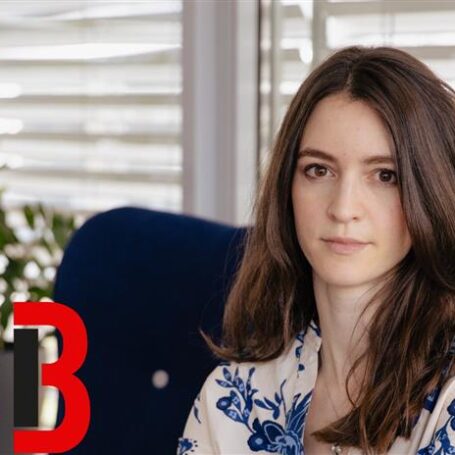Paul Seabright on the Relationship Between the Sexes
There is still a great deal of inequality between the sexes in the workplace. In this episode of the Social Science Bites podcast Paul Seabright combines insights from economics and evolutionary theory to shed light on why this might be so.
Click HERE to download a PDF transcript of this conversation. The full text also appears below.
To directly download this podcast, right click HERE and “Save Link As.”
Social Science Bites is made in association with SAGE. For a complete listing of past Social Science Bites podcasts, click here.
***
David Edmonds: Women occupy fewer positions of power in business than men. Why is that? What explains the types of relationships that men have with women, and the different ways in which men and women network with friends and acquaintances? Paul Seabright combines an economist’s perspective, with insights from biology and evolutionary science, to give answers to just these questions.
Nigel Warburton: Paul Seabright, welcome to Social Science Bites.
Paul Seabright: Hello.
Nigel Warburton: The topic we’re going to focus on is the relationship between the sexes. Now, you’re an economist, so why on earth would we go to an economist to investigate that topic?
Paul Seabright: Oh, surprise value. Nobody thinks economists are interested in sex, and it will sell more books that way. If you want a serious answer: it has to do with the fact that the relationship between the sexes is one of the most economic relationships there has ever been. Let me put it two ways; one is, it’s about co-operation. Sexual reproduction is the most co-operative activity in the universe. That’s true whether you’re talking about sexual reproduction between fish, or birds, or any kind of animal, but humans have taken it to a very extreme form. The amount that we invest in our offspring is, by the standards of the animal kingdom, absolutely spectacular. We have offspring that are dependent on us for nearly two decades, which is massively longer than any other species, and that requires a sort of massive co-operative endeavor.
Nigel Warburton: So that’s the first reason. What’s the second?
Paul Seabright: The second reason has to do with the role of scarcity. Economics is really the science of scarcity, and I was fascinated when I first did biology of sexual reproduction, apart from the aspects that would fascinate any adolescent doing the biology of sexual reproduction – what really interested me intellectually about this was that here you have a technology, if you like, which uses the same amounts of male inputs and female inputs, one sperm, one egg, and yet the eggs are incredibly scarce and the sperm are incredibly abundant. The woman produces one egg a month, and men produce a thousand sperm a second, and there seemed to be something spectacularly weird and wasteful about that. Here was this very strange technology in which you were doing something together, collectively, you had one input that was very scarce, and the other that was very abundant. And of course what it means, and that’s why it’s so interesting from an economic point of view, is that you have an enormous amount of competition among those sperm and their progenitor, to be the favored ones that actually get to fertilize the eggs.
The amount that we invest in our offspring is, by the standards of the animal kingdom, absolutely spectacular. We have offspring that are dependent on us for nearly two decades, which is massively longer than any other species, and that requires a sort of massive co-operative endeavor.
Nigel Warburton: Human sexual reproduction itself doesn’t take all that much co-operation, depending how you do it, but bringing up the children certainly does. The other aspect that you mentioned, this scarcity of eggs, clearly has a huge impact on how sexual relations occur and are negotiated. But what conclusions did you draw from these two aspects?
Paul Seabright: Well, the fact that sexual reproduction doesn’t require, as you say, a huge amount of co-operation, but it’s the bringing up of the children that does, implies that we should expect natural selection to have made us very careful how we use sexual reproduction because of the kinds of commitments that it entails. Now that’s obviously true for women, and more generally for females in most species, because they have scarce opportunities to reproduce precisely because their eggs are scarce: they don’t want to waste them on unsuitable males. And that has created a very profound logic in female approaches to reproduction throughout the animal kingdom, which is that females are selective. Now males aren’t so selective for the very simple reason that one reproduction opportunity doesn’t stand in the way of many possible others, and so you get this selection for selectivity on the part of females, and persistence on the part of males, which is utterly, profoundly at the heart of sexual relations in almost all species, but it takes in our species a rather different form because the stakes are so high. A woman in the Pleistocene era who had sex with unsuitable males would have found herself with sub-standard offspring, from the point of view of natural selection, and not able to have better quality offspring until she had given birth to those, and weaned them, and at least tried to ensure that they survived to adulthood. So that sense that for women, reproduction was a massively costly thing to undertake, has, I think, shaped emotions and attitudes to sexuality that persist to the present day.
Nigel Warburton: Well, if we accept your evolutionary accounts of these different outlooks on reproduction that men and women have, what follows for our situation now?
Paul Seabright: Well, there are a number of things that follow. First of all, at a relatively general level, I think we really have to understand that natural selection doesn’t select for optimal relationships. That’s where some insight from economics, and specifically from Game Theory, is really very helpful. Because one of the things you learn when you start to do simple Game Theory is that even if the players in a game are each doing as well as they can, given what the others are doing, then the outcome could be a lot worse for both of them than some other imaginable outcome. There’s a famous case of this known as the Prisoner’s Dilemma where each of us may be doing as well as we can, given what the others are doing, but we’re both doing a lot worse off than if we could somehow commit to a collectively better outcome. So, there are lots of examples of sexual relationships which are extremely wasteful, violent, unhappy for all the parties, and if you think that that’s just because something which natural selection should have selected for, but has gone wrong for mysterious reasons, then I think it’s much harder to think about how to fix that.
If, instead, you think well, natural selection never really selected for the relationship to be optimal, what it did select was for various kinds of traits and behaviors, to be fitness-maximizing for the individuals, or rather more strictly speaking, likely to lead to the copying of the genes that made those traits more likely to happen, then we can understand why all of the parties to a relationship may be stuck in a set of outcomes that could be dysfunctional, could be costly, could be violent, could be wasteful, but for reasons that can’t simply be put down to either mysterious dysfunction, or to individuals not doing what’s in their own interest.
Nigel Warburton: Well let’s take an example. In the workplace there is still a large amount of inequality between the sexes and one story is that’s because there’s a tradition of inequality and there are cultural factors which dominate there, so there’s a lot of sexism in the workplace typically. Now is that a plausible account of what’s going on, or are you saying that if we look at the evolutionary account, we’re going to get a new insight into why, for instance, there are so few women on the boards of major companies?
Paul Seabright: Yes, you’ve got to remember that things have changed enormously in the workplace in a pretty short time. For all of pre-history and for all of recorded history until about a century ago, large areas of working life were closed to women. It didn’t change until the 20th century when, first of all, political emancipation took place, and then after the Second World War when there was this astonishing change, and you know, women moved into all sorts of areas of working life that had, until then, been essentially male domains. Now, I think it’s important to bear that in mind, not because I want to be triumphalist and say that’s solved the problems, but because you can have a more intelligent discussion about why remaining areas of working life, such as the pockets of power at the top of major companies, still remain relatively closed to women if you understand it against the perspective of enormous moves by women elsewhere. If you just say it’s something like patriarchy, you know, the men will always resist, you can’t understand why patriarchy hasn’t stopped women, for example, from occupying now a majority of managerial and professional occupations in the Unites States economy. So the work of an evolutionary explanation is to see whether there are any aspects of the way that we behave that might explain why women found it much harder to make inroads in some areas than others, and the sort of thing that I have in mind is those areas of life where recruitment to control over important economic resources is done informally through informal networks, which then tap into rather different ways in which women and men have networked since pre-history.
Nigel Warburton: Could you give a specific example of that?
Paul Seabright: Yes, there’s a wonderful book by the primatologist Frans De Waal called ‘Peacemaking Among Primates’ in which he shows how male chimpanzees form coalitions that are rather unstable, opportunistic, unreliable; they’re constantly fighting, but they’re also opportunistic in a good way, so you can get a group of chimps fighting, and then they discover a source of food and they all make up and rush off to get the food. It’s very rare for female chimps to fight, or at least comparatively rare, but once they fight, it’s very unlikely that they’ll suddenly make up and go off to find food. Now that simple contrast turns out to be interestingly predictive of the way in which men and women behave in more modern ways, and that makes sense because in forager societies, women had to construct rather complex alliances and coalitions to help look after their children, and they certainly couldn’t rely, as once upon a time we used to think they relied, on their pair bonds, on the biological fathers. The biological fathers would be part of the coalition that they would construct, but only a part. Instead what they had to do was put together a sort of team of reliable people who would help make sure that their children didn’t starve, or get taken away by predators or killed by human rivals, and in order to do that they had to be fantastically selective about who they trusted. Males needed to be a bit selective too, but for quite different reasons – they would form coalitions for fighting and warfare, and those coalitions could be temporary, opportunistic, you needed a group that you could go off and fight an enemy with, but after that they didn’t have, necessarily, to be with you all the time, they didn’t have to help you keep looking after your children. Now it turns out that those kind of stable, loyal coalitions have some echo in the way in which women construct friendship networks in the modern world.
The problem is that those stable, loyal networks, which sound like a very good thing, don’t do enough to get them noticed in the big, anonymous world of recruitment to modern business jobs, and particularly senior jobs. I’m very interested in the way in which ways of networking have different implications for the degree of conspicuousness for talented men and women.
Nigel Warburton: If I’ve understood you correctly and this isn’t a caricature, one way of understanding what goes on in a large business today is to model it on chimpanzee society and say, ‘Well, look, the male chimpanzees are pretty good at making the kind of networking decisions that allow them to thrive in the business world, but the vestiges of the female chimpanzee type of networking are actually counterproductive in that environment now.’
Paul Seabright: Yes, I think that’s an amusing analogy. And, like all amusing analogies, can be full of insight but shouldn’t be pushed too far. Where the analogy works is in the contrast between the greater superficiality, but also the greater opportunism, of male networks, and the greater loyalty and stability of female networks. If you have networks comprised largely of relatively reliable, stable, loyal relationships, I don’t want to imply that that’s dysfunctional, on the contrary, it’s very, very good for lots of things, it just may not be so easy to adapt to getting ahead in a business environment. I also don’t want to imply that I think all that we need to do is to realize this and we can then snap out of it. One of the things that may be important, for instance, is for recruiters to positions of power in major corporations to start being aware of just how many talented women there are outside their rather narrow field of focus.
Nigel Warburton: See, now I’m tempted to say ‘Well look, you’re generalizing about men and women, why not just talk about people because there’s so much variety between individuals? Can we really reduce it to biology in this way, given that there are so many cultural aspects overlaying the biology?
Paul Seabright: There are an enormous number of cultural aspects overlaying the biology and clearly reduction to biology would be a great mistake. And in fact, one of the lessons that biology tells us about Homo sapiens is that we have evolved to be a very culturally sensitive species where we can adapt to very many different cultural environments. But at the same time, if you and I walk out into a big office just like that outside the one we’re recording in at the moment, I bet you that if we had one of these forms of brain damage which meant that we couldn’t look at the face of the speaker and tell what sex the speaker was, we could simply from the way they dressed, tell something about what sex they were, and that’s not just because of arbitrary code, it’s not just that in this office men don’t wear skirts – we know that in parts of Scotland, they do wear skirts and historically they have worn skirts – it’s rather that there are ways in which color, for example, is used by men and women. There’s not much doubt in your or my minds as to who’s male and who’s female in this office, even if there may be certain cases on the borderline where we’d have a little difficulty.
Nigel Warburton: What about the issue that any evolutionary story is speculative? We can’t go back to the Pleistocene to observe how evolution actually happened, and the evidence that remains is very slight in terms of behavioral traces. So how do we ever know if we’re right in this sort of speculative story?
Paul Seabright: OK. I think there’s a very interesting methodological difference between working on the distant past and working on the present and that is simply the fact that most of the evidence that we can reasonably get, is likely to be already to hand, and it’s very incomplete. Now, that doesn’t mean there isn’t evidence, but it does mean that the evidence is going to underdetermine the possible through hypotheses to a much greater extent than in the modern world. I mean in the modern world, you may have two hypotheses that look pretty close to each other on existing evidence and then you can go and generate an experiment or something that will help to decide between them.
Now, I don’t think we should underestimate how fast archaeology, for example, has moved on in recent years: techniques for dating, techniques for interpreting archaeological remains have moved ahead spectacularly, as has our ability to use them to interpret and to test hypotheses about the past. It’s very important therefore, to distinguish the correct criticism that it’s hard to find good enough evidence to test convincingly many of the hypotheses that we can develop about the distant past, from the incorrect claim that hypotheses about the distant past are intrinsically ‘just so stories’ which we couldn’t imagine even in principle testing. Most of them are not. Most of them are hypotheses that are, in principle testable, practically difficult to test, but not always impossible to test, and I can think of lots of things that would essentially disprove hypotheses about the distant past, hypotheses about behavior in the Pleistocene for example, are not wholly arbitrary because one of the things about past behavior is that it leaves, through natural selection, marks on current anatomy. So we can actually develop hypotheses based on current anatomy that are testable by comparing different species across each other. Again I come back to the fact that the difference between a hypothesis which is in principle testable, but practically difficult to test, and one that isn’t even testable in principle, is absolutely crucial here.
Nigel Warburton: Now, you’re an economist which is a branch of the social sciences in most people’s assessment. Do you see yourself as a social scientist, and if so, what part is played by the scientist bit?
Paul Seabright: I think the science requires you to test conjectures against evidence wherever you can, and I’m struck by the number of questions on which I’ve changed my mind in the last few years as I’ve looked more closely at the evidence. So let me give you an example: I have looked recently in a lot of detail at the evidence on gender and IQ and more generally intelligence and personality testing. Now, before I did that, I had a prior view that when I looked at it, I was likely to find substantial overall gender differences in IQ, and I was a little worried about that because I was nicely comfortable in my previous belief that there probably weren’t any differences. Now, it turned out that I was wrong, at least I was wrong in not a very straightforward way: there are a lot of differences between men and women with respect to particular capacities and talents that we have for various things. So in a lot of contexts men perform better than women on tests of visual, spatial skills. Women tend to perform better than men on tests of verbal comprehension. What I discovered looking at this, was the extent to which nobody, but nobody, has come up with a sensible overall theory about how you would weight these different talents and constituent competences against each other.
So it’s a little bit like the old early days of doing national income accounting when people sort of said, ‘Well, how are you going to measure the performance of an economy when it produces apples and nuclear submarines and software programs and musical performance and so on?’ and, eventually, a well-developed theory was worked out, that you would weight the production of all of these different things according to their relative prices because those prices represent the contribution to marginal utility. Now there is no theory, but no theory, that explains how you should weight performance in a test of visual spatial rotation of objects in three-dimensional space versus a test of performance of verbal comprehension. And I think we need that, and we need a more open and frank debate about it, which has been very difficult to have because it’s been taboo for so long to discuss even the possibility that there might be gender differences in performance in tests. And it’s about time we started to see, you know, which of those tests actually better match the kinds of talents that we need in a modern economy. And I’m not at all sure that the answer when it comes up will either be systematically in favor of one sex or the other, and whether we’re going to see any very interesting gender differences along those lines at all.
Nigel Warburton: I mean, that’s an interesting case of psychological research which has certain sorts of presumptions about the relative weighting of different aspects of intelligence, but it’s still got this basis on a human construct which is the idea of an intelligent person, which is not a natural kind, as it were. It’s not as if you’re going out and measuring the temperature at which water boils.
Paul Seabright: No, it’s absolutely not a physical constant. On the other hand, the interesting way to think about talents is they’re just a bundle of competences that we have. And the interesting talents that an economist wants to look at is talents for doing things that other people value, and that’s because we’re not just social animals, but we’re animals that live by exchange. So there are lots of things that matter for my happiness, but that essentially I do for myself; but there are a lot of other things that matter for my well-being which I do because other people value what I do. So, I cannot survive by eating my own economics lectures, but fortunately I manage to persuade other people to pay me enough to buy my food, in return for my delivering economics lectures. All of us, therefore, live by exchange. So, of course, you’re right, that’s not what philosophers would call a natural kind: it’s a bundle of different capacities which may not have any very close relationship to each other. But to go from that to say that there’s no stability in the things that make people good at doing the things that people value, I think would be a mistake.
Nigel Warburton: How important do you think the social sciences are in terms of, not just understanding what kind of beings we are, and what we’re up to, but changing the way that we are?
Paul Seabright: That’s a really difficult one for me to answer because I do social science because it’s fun. For me, it’s like gossip. Social science is just formalized and codified gossip. But let me give you what I think is the best answer. There’s a book by Steven Pinker called The Better Angels Of Our Nature, and it deals with something that I’ve thought about a lot in the past which is about why the levels of violence in modern societies are so much lower than they’ve been, both in recorded history and in pre-history. Now that’s a really interesting fact, and the best explanations for that fact have to do with a more systematic understanding of our social environment, which we have been able to put to work. It’s a complex thing, it’s not just about reason replacing emotion: it’s a lot about reason harnessing emotion and reason understanding our emotions better so as to put them to do good social work. But it is about creating very complex and subtle webs of incentives in the modern institutions that surround us that simply make it a better bet for most of us to handle our differences peacefully rather than to fight and to kill each other. There’s not been a single social innovation that’s done that: there’s just been an enormous number of small innovations that have brought that about, largely piggy-backing on the gradually improving and more systematic understanding of how other people behave.
Nigel Warburton: Paul Seabright, thank you very much.
Paul Seabright: Thank you.
Listen to other podcasts by Social Science Bites:
Robert Shiller on Behavioral Economics
Sonia Livingstone on Children and the Internet
Richard Sennett on Co-Operation
Rom Harré on What is Social Science?























































































There’s a lot of circular logic in this kind of thinking–what is really a kind of evolutionary functionalism. The steps are to take a contemporary phenomenon (say, workplace gender relations) and then reverse engineer an evolutionary story that fits the phenomenon. As long as it’s a tight-fitting story–the evolutionary logic seems right–there doesn’t seem to be any need for real evidence.